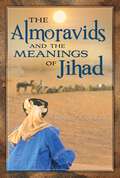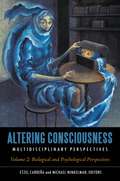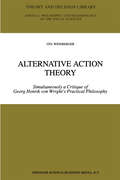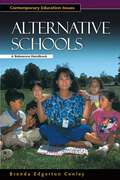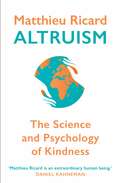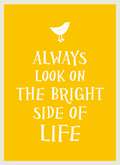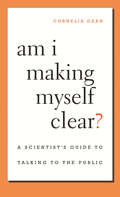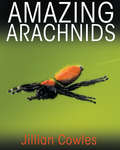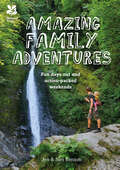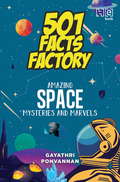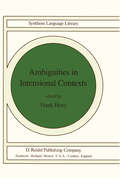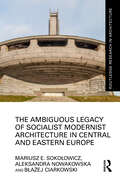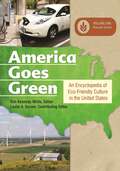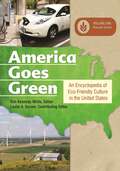- Table View
- List View
The Almoravids and the Meanings of Jihad
by Ronald A. MessierThis book offers a scholarly, highly readable account of the 11th-12th century rulers of Morocco and Muslim Spain who offered a full range of meanings of jihad and challenged Ibn Khaldun's paradigm for the rise and fall of regimes.Originally West African, Berber nomads, the Almoravids emerged from what is today Mauritania to rule Morocco, western Algeria, and Muslim Spain. Over the course of the century-long lifespan of the Almoravid dynasty, the concept of jihad evolved through four distinct phases: a struggle for righteousness, a war against pagans in the Sahara to impose their own sense of righteousness, war against "bad" Muslims in Sijilmasa and the rest of the Maghrib, and finally, war against Christian infidels—the Christian kings of Iberia.The Almoravids and the Meanings of Jihad takes readers through a clear chronology of the dynasty from its birth through its dramatic rise to power, then its decline and eventual collapse. Several important themes in North African history are explored throughout the book, including the dynastic theory of noted Arab historian Ibn Khaldun, the unique relationship of rural and urban lifestyles, the interactions of distinct Berber and Arab identities, and the influence of tribal solidarity and Islam in forming the social fabric of medieval North African society
Altering Consciousness [2 volumes]: Multidisciplinary Perspectives [2 volumes]
by Etzel Cardeña Michael J. WinkelmanThis authoritative, multidisciplinary overview of altered states of consciousness (ASC) shows how their study is necessary to gain a fundamental understanding of human culture, history, and biology.Altered consciousness is one of humanity's most mystical and life-altering aspects. These remarkable changes in mental state have understandably been a topic of general interest and scientific inquiry across time. Beyond simply satisfying our curiosity, however, studies focused upon altered consciousness can also bring valuable insights into our experience, biology, and culture.This unprecedented two-volume set will intrigue anyone interested in psychology, biology and neurology, science, history, arts and the humanities, and literature on consciousness, from general readers to scholars and researchers. An impressive collection of international contributors address altered states of consciousness from the perspectives of history, evolution, psychology, culture, literature, human biology, contemporary science, and society, seeking to illuminate the causes, effects, and meanings of altered consciousness. The first volume provides an introduction and centers on the importance of altered states in history, culture, and the humanities, while the second volume presents biological and psychological perspectives on altered consciousness and examines their potential for healing and pathology.
Altering Nature: Volume II: Religion, Biotechnology, and Public Policy (Philosophy and Medicine #98)
by Gerald P. McKenny B. A. Lustig B. A. BrodyB. Andrew Lustig, Baruch A. Brody, and Gerald P. McKenny In this second volume of the “Altering Nature” project, we situate specific religious and policy discussions of four broad areas of biotechnology within the context of our interdisciplinary research on concepts of nature and the natural in the first volume (Altering Nature, Concepts of Nature and the Natural in Biotechnology Debates). In the first volume, we invited five groups of scholars to explore the diverse conc- tions of nature and the natural that shape moral judgments about human alterations of nature, as especially exemplified by recent developments in biotechnology. A careful reading of such developments reveals that assessments of them—whether positive or negative—are often informed by different conceptual interpretations of nature and the natural, with differing implications for judgments about the app- priateness of particular alterations of nature. These varying interpretations of nature and the natural often result from the distinctive perspectives that characterize va- ous scholarly disciplines. Therefore, in an effort to explore the variety of meanings that attend discussions of the concepts of nature and the natural, the contributors to the first volume of Altering Nature addressed those concepts from five different disciplinary vantages. A first group of scholars analyzed a range of religious and spiritual perspectives on concepts of nature and the natural. Their research highlighted the thematic, h- torical, and methodological touchstones in those traditions that shape their persp- tives on nature.
Altering Nature: Volume I: Concepts of ‘Nature’ and ‘The Natural’ in Biotechnology Debates (Philosophy and Medicine #97)
by Gerald P. McKenny B. A. Lustig B. A. BrodyB. Andrew Lustig, Baruch A. Brody, and Gerald P. McKenny Nearly every week the general public is treated to an announcement of another actual or potential “breakthrough” in biotechnology. Headlines trumpet advances in assisted reproduction, current or prospective experiments in cloning, and devel- ments in regenerative medicine, stem cell technologies, and tissue engineering. Scientific and popular accounts explore the perils and the possibilities of enhancing human capacities by computer-based, biomolecular, or mechanical means through advances in artificial intelligence, genetics, and nanotechnology. Reports abound concerning ever more sophisticated genetic techniques being introduced into ag- culture and animal husbandry, as well as efforts to enhance and protect biodiversity. Given the pace of such developments, many insightful commentators have proclaimed the 21st century as the “biotechnology century. ” Despite a significant literature on the morality of these particular advances in biotechnology, deeper ethical analysis has often been lacking. Our preliminary review of that literature suggested that current discussions of normative issues in biotechnology have suffered from two major deficiencies. First, the discussions have been too often piecemeal in character, limited to after-the-fact analyses of particular issues that provoked the debate, and unconnected to larger concepts and themes. Second, a crucial missing element of those discussions has been the failure to reflect explicitly on the diverse disciplinary conceptions of nature and the natural that shape moral judgments about the legitimacy of specific forms of research and their applications.
Alternative Action Theory: Simultaneously a Critique of Georg Henrik von Wright’s Practical Philosophy (Theory and Decision Library A: #26)
by Ota WeinbergerAction is conceived of as an intentional behavior of an individual or of an institutional subject; it is determined by information processing, namely by a process in which pieces of descriptive and practical information are involved. Action is explained by a formal and finalistic theory which is connected with a specific theory of institutions. The philosophical basis of the logic of norm sentences and of other systems of practical thinking (formal teleology, axiology, logic of preferences) is discussed. The author criticizes traditional deontic logic and argues in favor of a genuine logic of norms. The book gives a structure analysis of the so-called practical inference and of nomic causal propositions. Besides a critical account of von Wright's practical philosophy the author offers critical analyses of discourse rationality (Habermas, Apel, Alexy) and of Wittgenstein's views on philosophizing. The book addresses readers interested in philosophical logic, practical philosophy, sociology of institutions, legal philosophy, and theory democracy.
Alternative Rechtsformen und Alternativen zum Recht (Jahrbuch für Rechtssoziologie und Rechtstheorie #6)
by Ekkehard KlausaAlternative Schools: A Reference Handbook (Contemporary Education Issues)
by Brenda Edgerton ConleyAn examination of the growth and development of alternative schools in American society and their role in the public school environment.In Alternative Schools: A Reference Handbook, educator Brenda Edgerton Conley surveys the emerging alternatives to our conventional educational system—a system that is not only costly, but ineffective for many children.In a resource aimed at a broad audience—school administrators, politicians, and, most important, parents—Conley offers both a historical and a present-day perspective on alternative educational programs. What sets the alternative education movement apart, she argues, is its acknowledgment that we all learn differently. That knowledge has given rise to an explosion of exciting alternatives—from open schools to home schooling, from charter schools to church schools. These alternative schools are smaller and less bureaucratic, more responsive to the community, and more receptive to change.
Altruism: The Power of Compassion to Change Yourself and the World
by Matthieu RicardThe concern for the well-being of others could be the saving grace of the 21st century. Matthieu Ricard's Altruism, an erudite, brilliantly ranging synthesis of philosophy, psychology and ages old wisdom, is a radical call to kindness, which has the potential as a new global movement to answer the biggest problems of our time: the economy in the short term, life satisfaction in the mid-term, and the environment in the long term. As the faultlines of inequality and nationalism leave us ever more divided, Ricard challenges us to be better people - and in the process, make the world a better place.
Altruism in Cross-Cultural Perspective (International and Cultural Psychology)
by Douglas A. VakochAltruism in Cross-Cultural Perspective provides such a scholarly overview, examining the intersection of culture and such topics as evolutionary accounts of altruism and the importance of altruism in ritual and religion. The past decade has seen a proliferation of research on altruism, made possible in part by significant funding from organizations such as the John Templeton Foundation. While significant research has been conducted on biological, social, and individual dimensions of altruism, there has been no attempt to provide an overview of the ways that altruistic behavior and attitudes vary across cultures. The book addresses the methodological challenges of researching altruism across cultures, as well as the ways that altruism is manifest in difficult circumstances. A particular strength of the book is its attention to multiple disciplinary approaches to understanding altruism, with contributors from fields including psychology, anthropology, sociology, biology, communication, philosophy, religious studies, gender studies, and bioethics.
Altruism, Welfare and the Law (SpringerBriefs in Law #0)
by Charles Foster Jonathan HerringThis book is an assault on the notion that it is empirically accurate and legally and philosophically satisfactory to see humans as atomistic entities. It contends that our welfare is inextricably entangled with that of others, and accordingly law and ethics, in determining our best interests, should recognise the central importance of relationality, the performance of obligations, and (even apparently injurious) altruism.
Always Look on the Bright Side of Life
by Summersdale PublishersThis little book of sunshine is bursting with witty and optimistic quotes, perfect both for those who always see life sunny side up and for those who might need reminding of the silver lining now and then.
Am I Making Myself Clear?: A Scientist's Guide to Talking to the Public
by Cornelia DeanWhat we don’t know can hurt us—and does so every day. Climate change, health care policy, weapons of mass destruction, an aging infrastructure, stem cell research, endangered species, space exploration—all affect our lives as citizens and human beings in practical and profound ways. But unless we understand the science behind these issues, we cannot make reasonable decisions—and worse, we are susceptible to propaganda cloaked in scientific rhetoric. To convey the facts, this book suggests, scientists must take a more active role in making their work accessible to the media, and thus to the public. In Am I Making Myself Clear? Cornelia Dean, a distinguished science editor and reporter, urges scientists to overcome their institutional reticence and let their voices be heard beyond the forum of scholarly publication. By offering useful hints for improving their interactions with policymakers, the public, and her fellow journalists, Dean aims to change the attitude of scientists who scorn the mass media as an arena where important work is too often misrepresented or hyped. Even more important, she seeks to convince them of the value and urgency of communicating to the public. Am I Making Myself Clear? shows scientists how to speak to the public, handle the media, and describe their work to a lay audience on paper, online, and over the airwaves. It is a book that will improve the tone and content of debate over critical issues and will serve the interests of science and society.
Amazing Arachnids
by Jillian CowlesA richly illustrated and up-close look at the secret lives of spiders and other arachnidsThe American Southwest is home to an extraordinary diversity of arachnids, from spitting spiders that squirt silk over their prey to scorpions that court one another with kissing and dancing. Amazing Arachnids presents these enigmatic creatures as you have never seen them before. Featuring a wealth of color photos of more than 300 different kinds of arachnids from eleven taxonomic orders--both rare and common species—this stunningly illustrated book reveals the secret lives of arachnids in breathtaking detail, including never-before-seen images of their underground behavior.Amazing Arachnids covers all aspects of arachnid biology, such as anatomy, sociality, mimicry, camouflage, and venoms. You will meet bolas spiders that lure their victims with fake moth pheromones, fishing spiders that woo their mates with silk-wrapped gifts, chivalrous cellar spiders, tiny mites, and massive tarantulas, as well as many others. Along the way, you will learn why arachnids are living fossils in some respects and nimble opportunists in others, and how natural selection has perfected their sensory structures, defense mechanisms, reproductive strategies, and hunting methods.Covers more than 300 different kinds of arachnids, including ones new to scienceFeatures more than 750 stunning color photosDescribes every aspect of arachnid biology, from physiology to biogeographyIllustrates courtship and mating, birth, maternal care, hunting, and defenseIncludes first-ever photos of the underground lives of schizomids and vinegaroonsProvides the first organized guide to macroscopic mites, including photos of living mites for easy reference
Amazing Arachnids
by Jillian CowlesA richly illustrated and up-close look at the secret lives of spiders and other arachnidsThe American Southwest is home to an extraordinary diversity of arachnids, from spitting spiders that squirt silk over their prey to scorpions that court one another with kissing and dancing. Amazing Arachnids presents these enigmatic creatures as you have never seen them before. Featuring a wealth of color photos of more than 300 different kinds of arachnids from eleven taxonomic orders--both rare and common species—this stunningly illustrated book reveals the secret lives of arachnids in breathtaking detail, including never-before-seen images of their underground behavior.Amazing Arachnids covers all aspects of arachnid biology, such as anatomy, sociality, mimicry, camouflage, and venoms. You will meet bolas spiders that lure their victims with fake moth pheromones, fishing spiders that woo their mates with silk-wrapped gifts, chivalrous cellar spiders, tiny mites, and massive tarantulas, as well as many others. Along the way, you will learn why arachnids are living fossils in some respects and nimble opportunists in others, and how natural selection has perfected their sensory structures, defense mechanisms, reproductive strategies, and hunting methods.Covers more than 300 different kinds of arachnids, including ones new to scienceFeatures more than 750 stunning color photosDescribes every aspect of arachnid biology, from physiology to biogeographyIllustrates courtship and mating, birth, maternal care, hunting, and defenseIncludes first-ever photos of the underground lives of schizomids and vinegaroonsProvides the first organized guide to macroscopic mites, including photos of living mites for easy reference
Amazing Family Adventures
by Jen Benson Sim BensonWhether orienteering, building dens or making a house for a hedgehog, this guide is the ideal way for all the family to interact with wildlife and nature and find adventures in wild places.
Amazing Space Mysteries and Marvels
by Gayathri Ponvannan• It rains diamonds on Saturn. And on Jupiter. And on Neptune too! • A comet once fell into the sun…and came out of the other side! • Some stars turn into black holes! Humans have been gazing at the skies for ages, trying to figure out just what lies beyond us. Over the years, we have calculated the speed of light, the brightness of stars and the size of galaxies. We have landed spacecraft on our moon and on Saturn’s moon too. We have even sent probes that are currently travelling beyond the solar system, complete with messages for aliens! From the Big Bang to the Big Freeze, from the greatest theories to the weirdest mistakes, from the far reaches of the universe to our closest celestial neighbours, Amazing Space Mysteries and Marvels covers stars, moons, planets, comets, asteroids, meteors, galaxies, black holes and many more out-of-the-world topics that will make you go ‘ooh’ and ‘aah’! With bite-sized information and photographs, this well-researched book is perfect for aspiring astronauts and anybody curious about the mysteries of the universe. What are you waiting for? Step into the 501 Facts Factory for a spectacular journey through space. '
Ambiguities in Intensional Contexts (Studies in Linguistics and Philosophy #12)
by Frank HenyThe essays in this book deal with a number of problems in the analysis of intensional language - more especially with the analysis of the personal modalities in natural language. Together they cover a representative spectrum of the problems of contemporary ,interest in this area, in a way that should make them of interest to linguists, logicians and philosophers concerned with natural language. The contributors are mostly more linguists than logicians or philosophers but some are more logicians or philosophers than linguists. As far as possible, we have tried to conduct the discussion in terms that will enable students from any of these fields to come to grips with the central issues. This volume will provide, I think, material for a very stimulating course. I have used it as the basis for a course at the introductory level in the philosophy of language. The essays in the book led us back to look at the classic texts and a good deal of the intervening literature crept in of its own accord. Out of that experience grew the introduction that follows. In contrast with the rest of the book, the introduction is frankly pedagogical. I hope and believe that many who would otherwise find the papers themselves hard to digest will ~e helped on their way by that summary.
The Ambiguities of Desistance: Ex-offenders, Higher Education and the Desistance Journey (Emerald Points)
by David HoneywellIntroducing nuanced and rich data around the growing interest in desistance and what leads someone to move away from crime, this book explores the ongoing and individual desistance journeys of ex-offenders during re-integration into society. Through in-depth interviews and his own lived experiences as a prisoner, the author highlights the importance of Higher Education in the desistance process as a conduit for change and rehabilitation. He explores the complex life process of the ex-offender, investigating the introspective and existential experiences that lead individuals towards an ongoing desistance journey in which they re-evaluate their sense of selves and develop new identities. Arguing that in the current criminal justice system the focus on crime overshadows the more complex and unending process of desistance, the author showcases how the system provides no formal rite of passage for ex-offenders attempting to re-integrate into society. In response to this, this book synthesises and critically reviews desistance theory as it has emerged within contemporary criminology, and offers an opportunity for readers to engage with the complexities of the lives analysed in this research.
The Ambiguities of Desistance: Ex-offenders, Higher Education and the Desistance Journey (Emerald Points)
by David HoneywellIntroducing nuanced and rich data around the growing interest in desistance and what leads someone to move away from crime, this book explores the ongoing and individual desistance journeys of ex-offenders during re-integration into society. Through in-depth interviews and his own lived experiences as a prisoner, the author highlights the importance of Higher Education in the desistance process as a conduit for change and rehabilitation. He explores the complex life process of the ex-offender, investigating the introspective and existential experiences that lead individuals towards an ongoing desistance journey in which they re-evaluate their sense of selves and develop new identities. Arguing that in the current criminal justice system the focus on crime overshadows the more complex and unending process of desistance, the author showcases how the system provides no formal rite of passage for ex-offenders attempting to re-integrate into society. In response to this, this book synthesises and critically reviews desistance theory as it has emerged within contemporary criminology, and offers an opportunity for readers to engage with the complexities of the lives analysed in this research.
The Ambiguous Legacy of Socialist Modernist Architecture in Central and Eastern Europe (Routledge Research in Architecture)
by Mariusz E. Sokołowicz Aleksandra Nowakowska Błażej CiarkowskiThis book examines the unique socialist-modernist architecture built in the twentieth century in Central and Eastern Europe as a source of heritage and of existing and potential value for the present and future generations. Due to the historical context in which it was created, such architecture remains ambiguous. On the one hand, the wider public associates it with the legacy of the unpleasant period of the real socialist economic regime. Yet, on the other hand, it is also a manifestation of social modernization and the promotion of a significant proportion of the population. This book focuses particularly on concrete heritage, a legacy of modernist architecture in Central and Eastern Europe, and it was this material that enabled their rebuilding after World War II and modernization during the following decades. The authors search for the value of modernist architecture and using case studies from Poland, Bulgaria, Northern Macedonia, Lithuania and Slovenia verify to what extent this heritage is embedded in the local socio-economic milieu and becomes a basis for creating new values. They argue that the challenge is to change the ways we think about heritage, from looking at it from the point of view of a single monument to thinking in terms of a place with its own character and identity that builds its relation to history and its embeddedness in the local space. Furthermore, they propose that the preservation of existing concrete structures and adapting them to modern needs is of great importance for sustainability. With increasing awareness of the issue of preserving post-war architectural heritage and the strategies of dissonant heritage management, this multidisciplinary study will be of interest to architecture historians, conservators, heritage economists, urban planners and architects.
The Ambiguous Legacy of Socialist Modernist Architecture in Central and Eastern Europe (Routledge Research in Architecture)
by Mariusz E. Sokołowicz Aleksandra Nowakowska Błażej CiarkowskiThis book examines the unique socialist-modernist architecture built in the twentieth century in Central and Eastern Europe as a source of heritage and of existing and potential value for the present and future generations. Due to the historical context in which it was created, such architecture remains ambiguous. On the one hand, the wider public associates it with the legacy of the unpleasant period of the real socialist economic regime. Yet, on the other hand, it is also a manifestation of social modernization and the promotion of a significant proportion of the population. This book focuses particularly on concrete heritage, a legacy of modernist architecture in Central and Eastern Europe, and it was this material that enabled their rebuilding after World War II and modernization during the following decades. The authors search for the value of modernist architecture and using case studies from Poland, Bulgaria, Northern Macedonia, Lithuania and Slovenia verify to what extent this heritage is embedded in the local socio-economic milieu and becomes a basis for creating new values. They argue that the challenge is to change the ways we think about heritage, from looking at it from the point of view of a single monument to thinking in terms of a place with its own character and identity that builds its relation to history and its embeddedness in the local space. Furthermore, they propose that the preservation of existing concrete structures and adapting them to modern needs is of great importance for sustainability. With increasing awareness of the issue of preserving post-war architectural heritage and the strategies of dissonant heritage management, this multidisciplinary study will be of interest to architecture historians, conservators, heritage economists, urban planners and architects.
America Goes Green [3 volumes]: An Encyclopedia of Eco-Friendly Culture in the United States [3 volumes]
by Leslie A. DuramThis three-volume encyclopedia explores the evolution of green ideology and eco-friendly practices in contemporary American culture, ranging from the creation of regional and national guidelines for green living to the publication of an increasing number of environmental blogs written from the layperson's perspective.Evidence of humanity's detrimental impact on the environment is mounting. As Americans, we are confronted daily with news stories, blogs, and social media commentary about the necessity of practicing green behaviors to offset environmental damage. This essential reference is a fascinating review of the issues surrounding green living, including the impact of this lifestyle on Americans' time and money, the information needed to adhere to green principles in the 21st century, and case studies and examples of successful implementation.America Goes Green: An Encyclopedia of Eco-Friendly Culture in the United States examines this gripping topic through 3 volumes organized by A–Z entries across 11 themes; state-by-state essays grouped by region; and references including primary source documents, bibliography, glossary, and green resources. This timely encyclopedia explores the development of an eco-friendly culture in America, and entries present the debates, viewpoints, and challenges of green living.
America Goes Green [3 volumes]: An Encyclopedia of Eco-Friendly Culture in the United States [3 volumes]
by Leslie A. DuramThis three-volume encyclopedia explores the evolution of green ideology and eco-friendly practices in contemporary American culture, ranging from the creation of regional and national guidelines for green living to the publication of an increasing number of environmental blogs written from the layperson's perspective.Evidence of humanity's detrimental impact on the environment is mounting. As Americans, we are confronted daily with news stories, blogs, and social media commentary about the necessity of practicing green behaviors to offset environmental damage. This essential reference is a fascinating review of the issues surrounding green living, including the impact of this lifestyle on Americans' time and money, the information needed to adhere to green principles in the 21st century, and case studies and examples of successful implementation.America Goes Green: An Encyclopedia of Eco-Friendly Culture in the United States examines this gripping topic through 3 volumes organized by A–Z entries across 11 themes; state-by-state essays grouped by region; and references including primary source documents, bibliography, glossary, and green resources. This timely encyclopedia explores the development of an eco-friendly culture in America, and entries present the debates, viewpoints, and challenges of green living.
America in the World: A History in Documents from the War with Spain to the War on Terror
by Jeffrey A. Engel Mark Atwood Lawrence Andrew PrestonHow should America wield its enormous power beyond its borders? Should it adhere to grand principles or act on narrow self-interest? Should it partner with other nations or avoid entangling alliances? Americans have been grappling with questions like these throughout the nation's history, and especially since the emergence of the United States as a major world power in the late nineteenth century. America in the World illuminates this history by capturing the diverse voices and viewpoints of some of the most colorful and eloquent people who participated in these momentous debates.Spanning the era from the Gilded Age to the Obama years, this unique reader collects more than two hundred documents--everything from presidential addresses and diplomatic cables to political cartoons and song lyrics. It encompasses various phases of American diplomatic history that are typically treated separately, such as the First World War, the Cold War, and 9/11. The book presents the perspectives of elite policymakers--presidents, secretaries of state, generals, and diplomats--alongside those of other kinds of Americans, such as newspaper columnists, clergymen, songwriters, poets, and novelists. It also features numerous documents from other countries, illustrating how foreigners viewed America’s role in the world.Ideal for classroom use, America in the World sheds light on the complex interplay of political, economic, ideological, and cultural factors underlying the exercise of American power on the global stage.Includes more than two hundred documents from the late nineteenth century to today Looks at everything from presidential addresses to political cartoons and song lyrics Presents diverse perspectives, from elite policymakers to clergymen and novelists Features documents from outside the United States, illustrating how people in other countries viewed America’s role in the world
America in the World: A History in Documents from the War with Spain to the War on Terror (PDF)
by Jeffrey A. Engel Mark Atwood Lawrence Andrew PrestonHow should America wield its enormous power beyond its borders? Should it adhere to grand principles or act on narrow self-interest? Should it partner with other nations or avoid entangling alliances? Americans have been grappling with questions like these throughout the nation's history, and especially since the emergence of the United States as a major world power in the late nineteenth century. America in the World illuminates this history by capturing the diverse voices and viewpoints of some of the most colorful and eloquent people who participated in these momentous debates.Spanning the era from the Gilded Age to the Obama years, this unique reader collects more than two hundred documents--everything from presidential addresses and diplomatic cables to political cartoons and song lyrics. It encompasses various phases of American diplomatic history that are typically treated separately, such as the First World War, the Cold War, and 9/11. The book presents the perspectives of elite policymakers--presidents, secretaries of state, generals, and diplomats--alongside those of other kinds of Americans, such as newspaper columnists, clergymen, songwriters, poets, and novelists. It also features numerous documents from other countries, illustrating how foreigners viewed America’s role in the world.Ideal for classroom use, America in the World sheds light on the complex interplay of political, economic, ideological, and cultural factors underlying the exercise of American power on the global stage.Includes more than two hundred documents from the late nineteenth century to today Looks at everything from presidential addresses to political cartoons and song lyrics Presents diverse perspectives, from elite policymakers to clergymen and novelists Features documents from outside the United States, illustrating how people in other countries viewed America’s role in the world
